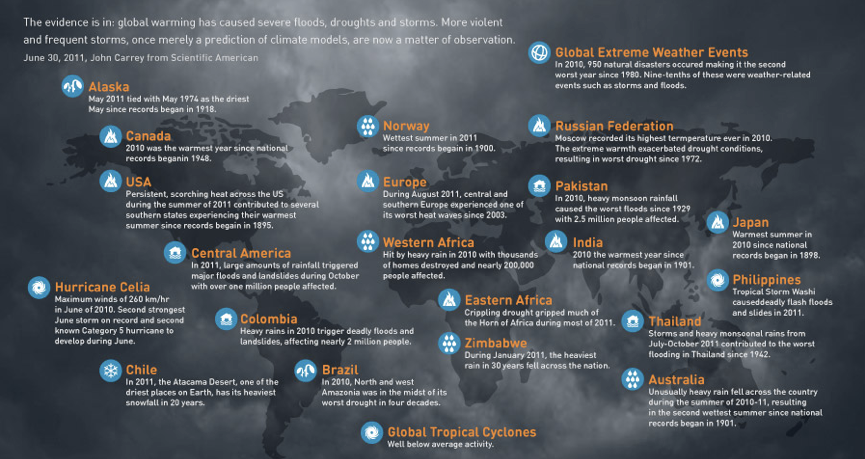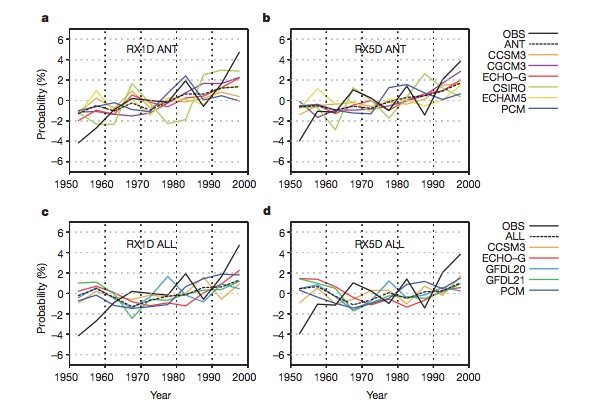frontier |ˌfrənˈti(ə)r|
noun
the extreme limit of understanding or achievement in a particular area
The impacts of climate change pile up in the extremes. This is the opening line in the IPCC video “In Harm’s Way” for the Special Report on Managing the Risks of Extreme Events and Disasters to Advance Climate Change Adaptation (SREX). http://www.youtube.com/watch?feature=player_embedded&v=Fq8P9RhEpiQ. There is naturally a great desire to understand extreme events and although many scientists have given causality to human activities, it is lately with the pile up that many more are ‘converting’ to the climate change acceptance frame of mind. This video also found it’s way onto the 350.org’s campaign to “Connect the Dots” between extreme weather and climate change. There is a growing activist movement to educate about the science and significance of climate change. The video for Connect the Dots itself gives a similar message: the increase in extreme weather events are strongly a result of human activity and, they are all connected to each other and the climate. http://youtu.be/pMNMvaBC4_U
The debate used be whether climate change could be human induced. In contemporary times the debate is more along the lines of, yes climate change can be human induced, but by how much is it? How badly is the climate being affected and to what extent is this altering our weather patterns? Climate is the canvas upon which weather paints its story. The intensification of weather extremes is shaking people to look at the science; which is there but more work is still needed. Now that more people want to know, the role of the scientist has grown to educator. Another question then, is how do you teach climate change? Well I guess these online videos and images are one way, but that is a discussion for another time and place.
 Figure 1. Infographic of recent extreme events around the world. (350.org)
Figure 1. Infographic of recent extreme events around the world. (350.org)
Min et al. (2011) in the journal Nature, showed that anthropogenic increases in greenhouse gasses have contributed to an intensification of heavy rainfall events across most of the Northern Hemisphere. Pall et al. (2011, a few pages after Min et al., 2011) gave insight into the human influence in global warming with impacts on flooding via precipitation and river-flow alteration. Both of these research letters in the same journal show the recent and growing evidence of human influence on rainfall. A scary result is that the models used have shown to underestimate the change in rainfall and thus precipitation related extreme events may become more intense than predictions allow.
Figure 2. “Time series of five-year mean area-averaged PI anomalies over Northern Hemisphere land during 1951–99. a, b, Model simulations with anthropogenic (ANT) forcing; c, d, model simulations with anthropogenic plus natural (ALL) forcing. For each pair of panels, results are shown for RX1D and RX5D precipitation amounts. Black solid lines are observations and dashed lines represent multi-model means. Coloured lines indicate results for individual model averages (see Supplementary Table 1 for the list of climate model simulations and Supplementary Fig. 2 for time series of individual simulations). Each time series is represented as anomalies with respect to its 1951–99 mean.” Min et al., 2011.
We are possibly at our extreme limit of understanding climate change. Any information we do not yet have, any phenomenon we do not yet understand, and any time wasted on denialism leads to greater disaster. There is no time to waste as “climate change isn’t a future problem anymore, it’s happening here and now” (350.org). At the front line of acceptance of the role of human activity on altering our cliamte, lies the devastating extreme weather events shown in the videos above.

Myra
“Climate is the canvas upon which weather paints its story”. I like this quote because I think it emphasizes the important difference between the two. Since weather is chaotic, I agree, it is almost impossible to attribute an _individual_ event to global warming. However, as mentioned above, the frequency and intensity of extremes in the bigger picture of climate, is what is more important. Using the loaded dice analogy -then: getting a six once proves nothing as compared to repeatedly getting the number six, several times. I guess what complicates this, is that while the intensity may be altered by global warming the frequency of some extreme events will not change (e.g. hurricanes), while for other events perhaps the opposite might be the case. Also, global warming could have both an indirect and direct influence the intensity of extreme events (e.g. elevated SST s might only help to explain an increase in the intensity of a hurricane and other factors such as wind shear) and I guess this raises issues of correlation vs. causality and makes ‘connecting the dots’ that much harder.
Stefaan
Also, I think the article discussed in the following blog is potentially interesting in this context:
http://thinkprogress.org/climate/2012/01/06/399350/hansen-extreme-heat-waves-texas-oklahoma-moscow-were-caused-by-global-warming/
The following article also raises some interesting points about inferring return periods of extreme weather events (low probability events):
http://journals.ametsoc.org/doi/abs/10.1175/JCLI4224.1
(Sorry, I don’t know how to make them appear as hyperlinks)
Stefaan
I’m concerned that some of the events highlighted in figure 1 barely point to climate change: the heaviest snowfalls in the Atacama desert in 20 years and “one of the worst” heat waves since 2003 in central and southern Europe could easily be the result of inter-annual or multidecadal variability. This does not, of course, detract from the significance or severity of the problem on the whole, but it does supply ammunition to those intent on sowing doubt. To what extent are climate change activism movements contributing to communication of the vital scientific messages of climate change? Is there a possibility that by trying to portray a close association between themselves and the scientific community, their less well-considered comments and claims can tarnish the reputation of climate scientists and make it appear to be a “cause” of a “green” fringe? These are important questions that I think should inform the tactics of “green” movements in general.
cbrodrick
There is little doubt that climate change is linked to increasing extreme weather events, but isn’t it frustrating when misinformed people attribute every remotely unusual weather/climate event to climate change without even pondering the existence of natural variability in a region’s climate? Events such as the 2010/2011 floods in Queensland and NSW, Australia are instantly labelled as “climate change induced” often just on the severity of the damage caused. But with urbanization and population growth in recent decades, people are forced to build on floodplains and other geographically unsuitable locations, hence the damage caused is far greater than a generation or two ago where the majority of people had the space to build on more suitable land, minimizing their vulnerability to such events. Being able to differentiate between natural variability and climate change, is crucial in enhancing our understanding of the climate system, and passing this information onto the layman is equally as important.